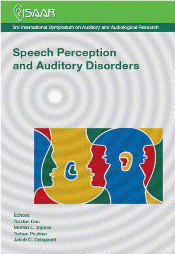Speech intelligibility with binaurally linked hearing aids
Abstract
Conventional compression algorithms in bilateral hearing-aid fittings distort the interaural level differences (ILD’s) due to independent gain characteristics at the two ears. By transmitting signals between hearing aids, the compression can be coordinated and the same gain can be applied to both ears, thus preserving the ILD’s. The present study investigated the influence of such “binaurally linked” hearing aids on speech intelligibility. Hearing-impaired listeners with a symmetric hearing loss were fitted with hearing aids connected to a hearing aid research platform (HARP). Speech reception thresholds (SRT’s) were measured in a loudspeaker setup with the target speech and the masker spatially separated. Slightly, but not significantly better SRT’s were achieved when the hearing aids were binaurally linked and combined with slow compression than when unlinked fast compression was used. The difference between monaural and binaural speech intelligibility was independent of the hearing aid algorithm. Thus, the preservation of the exact ILD information does not seem to be critical for binaural processing and speech intelligibility in the considered conditions.References
Bentler, R. A., Pavlovic, C. V. (1989). “Transfer functions and correction factors used in hearing aid evaluation and research.” Ear Hear. 10, 58–63.
Brand, T., Kollmeier, B. (2002). “Efficient adaptive procedures for threshold and concurrent slope estimates for psychophysics and speech intelligibility tests.” J. Acoust. Soc. Am. 111, 2801–2810.
Bronkhorst, A. W. and Plomp, R. (1988). “The effect of head-induced interaural time and level differences on speech intelligibility in noise.” J. Acoust. Soc. Am. 83, 1508–1516.
Dillon, H. (2001). Hearing aids. New York: Thieme, pp. 379–380.
Keidser, G., Rohrseitz, K., Hamacher, V., Carter, L., Rass, U., Convery, E. (2006). “The effect of multi-channel wide dynamic range compression, noise reduction, and the directional microphone on horizontal localization performance in hearing aid wearers.” Int. J. Audiol. 45, 563–579.
Moore, B. C. J., Johnson, J. S., Clark, T. M., Pluvinage, V. (1992). “Evaluation of a dual-channel full dynamic range compression system for people with sensorineural hearing loss.” Ear Hear. 13, 349–370.
Musa-Shufani, S., Walger, M., von Wedel, H., Meister, H. (2006). “Influence of dynamic compression on directional hearing in the horizontal plane.” Ear Hear. 27, 279–285.
Noble, W., Byrne, D., Ter-Horst, K. (1997). “Auditory localization, detection of spatial separateness and speech hearing in noise by hearing impaired listeners.” J. Acoust. Soc. Am. 102, 2343–2352.
Shinn-Cunningham, B. G. (2003). “Spatial hearing advantages in everyday environments.” Proceedings of the ONR workshop on Attention, Perception, and Modeling for Complex Displays. Troy, NY.
Sockalingam, R., Holmberg, M., Eneroth, K., Schulte, M., (2009). “Binaural hearing aid communication shown to improve sound quality and localization.” Hear. J. 62, 46–47.
Wagener, K., Josvassen, J. L., Ardenkjaer, R. (2003). “Design, optimization and evaluation of a Danish sentence test in noise.” Int J Audiol, 42, 10–17.
Downloads
Published
How to Cite
Issue
Section
License
Authors who publish with this journal agree to the following terms:
a. Authors retain copyright* and grant the journal right of first publication with the work simultaneously licensed under a Creative Commons Attribution License that allows others to share the work with an acknowledgement of the work's authorship and initial publication in this journal.
b. Authors are able to enter into separate, additional contractual arrangements for the non-exclusive distribution of the journal's published version of the work (e.g., post it to an institutional repository or publish it in a book), with an acknowledgement of its initial publication in this journal.
c. Authors are permitted and encouraged to post their work online (e.g., in institutional repositories or on their website) prior to and during the submission process, as it can lead to productive exchanges, as well as earlier and greater citation of published work (See The Effect of Open Access).
*From the 2017 issue onward. The Danavox Jubilee Foundation owns the copyright of all articles published in the 1969-2015 issues. However, authors are still allowed to share the work with an acknowledgement of the work's authorship and initial publication in this journal.


